Search
Search for "click":
(Click here to search this entire website for "click" with Google.)
 |

|
|
BATT-MON Click is a very versatile, high accuracy, multiple-chemistry battery gauge for applications single-cell batteries. It can be used for various applications, ranging from smartphones, notebook / laptops, power tools, vacuums, to energy storage systems (ESS), while providing the output voltage at the same time. The interesting feature of this device is that it can provide additional current to the connected load if the current provided from the mikroBUS™ socket is not enough. This is possible by utilizing the connected battery and by employing intelligent power routing algorithms of BATT-MON click.
The Click board™ is supported by the mikroSDK compliant library, which includes functions that simplify software development. The Click board™ comes as a fully tested product, ready to be used on a system equipped with mikroBUS™.
|
|
|
|
 |
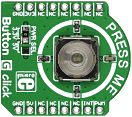
|
|
Button G click is the simplest solution for adding a single pushbutton to your design. The button itself is transparent, 6.8mm in diameter and has a green LED backlight. When pressed, it sends an interrupt signal to the target board microcontroller. The backlight LED is controlled separately through the mikroBUS PWM pin, so you can program all kinds of patterns (varying level of light intensity or rate of blinking on subsequent button presses). The board can use either a 3.3V or a 5V power supply. |
|
|
|
 |
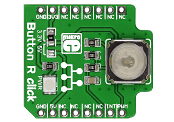
|
|
Button R click is the simplest solution for adding a single pushbutton to your design. The button itself is transparent, 6.8mm in diameter and has a red LED backlight. When pressed, it sends an interrupt signal to the target board microcontroller. The backlight LED is controlled separately through the mikroBUS PWM pin, so you can program all kinds of patterns (varying level of light intensity or rate of blinking on subsequent button presses). The board can use either a 3.3V or a 5V power supply. |
|
|
|
 |
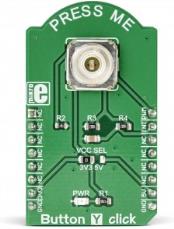
|
|
Button Y click is a Click board™ equipped with the tactile switch, sometimes referred to as a pushbutton. A pushbutton is a component that is used very often in various designs, allowing the user to interact with the application. Although it sounds simple, a button needs to comply with a range of application requirements. It needs to have a very good mechanical endurance while retaining its specifications, a predictable bouncing time, a very low ON resistance, very high OFF resistance, and it needs to fulfill aesthetical requirements.
It comes in the package which also includes the mikroSDK™ software and a library with all the functions. The Click board™ comes as a fully tested and approved prototype, making it a reliable device ready to use on the development board.
|
|
|
|
 |

|
|
CAN FD 2 Click is a HS CAN transceiver add on board, suitable for evaluation of TLE9255W CAN network transceiver from Infineon. The transceiver itself drives the signals to the CAN bus and protects the microcontroller from interference generated within the CAN network. Based on the high symmetry of the CANH and CANL signals, the TLE9255W provides a very low level of electromagnetic emission within a wide frequency range, allowing the operation of the TLE9255W without a common mode choke in automotive and industrial applications.
CAN FD 2 Click board™ is supported by a mikroSDK compliant library, which includes functions that simplify software development. This Click board™ comes as a fully tested product, ready to be used on a system equipped with the mikroBUS™ socket.
|
|
|
|
 |

|
|
CAN FD 3 Click is a add-on board based on TLE9251V CAN network transceiver, designed for HS CAN networks up to 5 Mbit/s in automotive and industrial applications. As an interface between the physical bus layer and the CAN protocol controller, the TLE9251V drives the signals to the bus and protects the microcontroller against interferences generated within the network. Given all the features its components offer, the CAN FD Click is best used for for infotainment applications, gateway modules, body control modules (BCM) or engine control units (ECUs).
CAN FD 3 Click board™ is supported by a mikroSDK compliant library, which includes functions that simplify software development. This Click board™ comes as a fully tested product, ready to be used on a system equipped with the mikroBUS™ socket.
|
|
|
|
 |

|
|
CapSense click features the CY8C201A0 capacitive sensing module, which takes human body capacitance as an input and directly provides real time sensor information output via I2C. The board contains capacitive sensing elements (5-segment slider and two buttons) as well as two LEDs. The CY8C201A0 capacitive controller has high immunity against radiated and conductive noise. The board can operate at either 3.3V or 5V, with selection by means of SMD jumper. |
|
|
|
 |
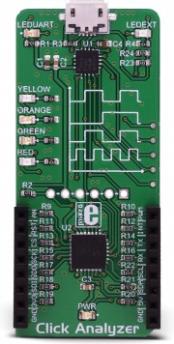
|
|
Click Analyzer is a smart and powerful tool for analyzing pin states and voltage levels on the mikroBUS™. It is a versatile and powerful smart analyzing tool, which consists of two 8-bit PIC microcontrollers (MCUs), from Microchip. By utilizing some of the capabilities of the PIC18F26K42 MCU, such as the DMA, CLC, SMT, and NCO to name few, it is possible to achieve measurement and monitoring of the voltage states on all the pins of the stackable mikroBUS™ slot. The stackable slot allows installation of any Click board™ on a top of the Click Analyzer, allowing easy and simple data traffic analysis. Click Analyzer offers several data transfer protocols, suitable both for various M2M applications, as well as for the human-machine interface (HMI) applications. |
|
|
|
 |

|
|
DC MOTOR click is a DC motor driver board in the mikroBUS form factor. It features the DRV8833RTY H-Bridge motor driver, 74HC4053 multiplexer and two screw terminals. The 74HC4053 IC is incorporated into the design so that the motor can be run using only the one PWM line available on the mikroBUS socket. DC MOTOR click communicates with the target board via SELECT1, SELECT2 and nSLEEP control lines; PWM input line and nFAULT feedback line. The board is designed to use either a 3.3V or 5V power supply. It can be powered from the mikroBUS socket, or externally through the CN2 screw terminals (3-10V). It is limited to a 0.9A driving current and has a 0.22R current sense resistor. The motor is connected to the CN1 screw terminal. |
|
|
|
 |
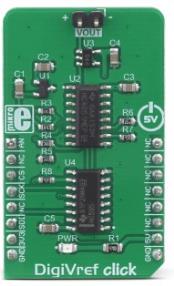
|
|
DigiVref click is a very precise voltage reference Click board™, which allows one of four different voltage values to be selected over the SPI interface. Once the selection is done, the voltage reference stays fixed, even when the SPI interface is completely disconnected. The voltage reference is buffered by an operational amplifier, and thus it is very stable. Thanks to the MCP1541, a high precision voltage reference IC, and high thermal stability used resistors, the output voltage remains highly regulated, keeping the thermal drift very low. It can be used whenever a precise voltage reference is required.
DigiVref click is supported by a mikroSDK compliant library, which includes functions that simplify software development. This Click board™ comes as a fully tested product, ready to be used on a system equipped with the mikroBUS™ socket.
|
|
|
|
 |
|
<< First
< Previous
Next >
|
|

